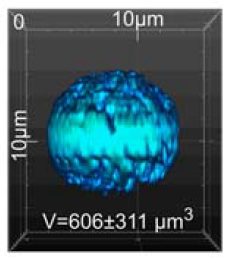Cell nuclei have lower refractive index and mass density than cytoplasm.
Common perception regards the nucleus as a densely packed object with higher refractive index (RI) and mass density than the surrounding cytoplasm. Here, the volume of isolated nuclei is systematically varied by electrostatic and osmotic conditions as well as drug treatments that modify chromatin conformation. The refractive index and dry mass of isolated nuclei is derived from quantitative phase measurements using digital holographic microscopy (DHM). Surprisingly, the cell nucleus is found to have a lower RI and mass density than the cytoplasm in four different cell lines and throughout the cell cycle. This result has important implications for conceptualizing light tissue interactions as well as biological processes in cells.
Back to list
